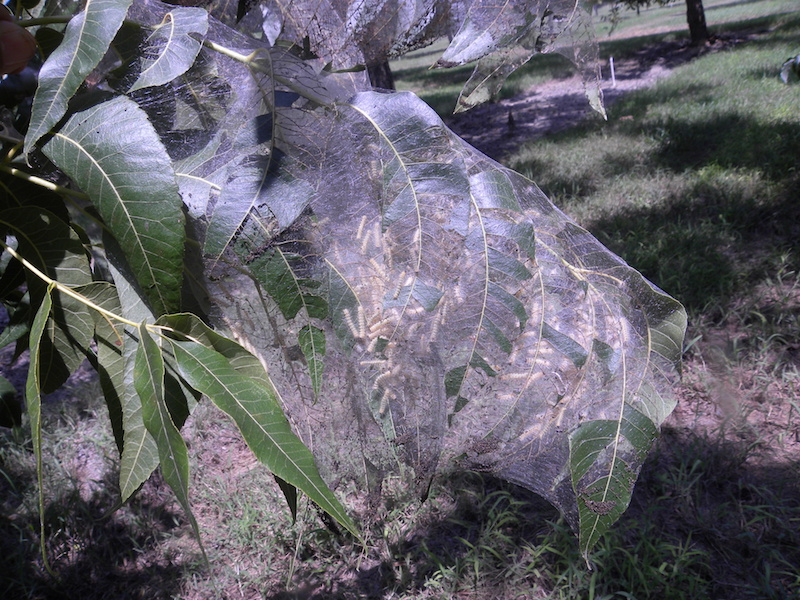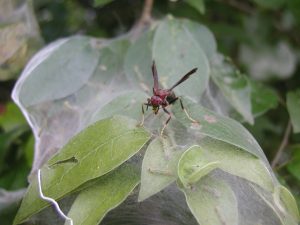Fall Webworm—Not a Big Threat, Just a Big Pest

Fall webworms have infested this pecan tree. (Photo by Bill Ree)
The fall webworm is native to North America where it feeds on a wide range of deciduous trees and shrubs, with feeding preferences varying on geographic regions. In North America, host plants include almost all ornamental, fruit, shade, and nut trees. Unfortunately, pecan is a common favorite host here in Texas.
In commercial orchards, I rarely see this insect as an economic threat, which I feel is the result of some of our insecticides applied for pecan nut casebearer. However, in urban areas where infestations are detrimental to the beauty of the tree and property, fall webworm is a greater concern.
At one time, it was thought there were two species of fall webworm, but it was determined that the species actually has two different races—a blackheaded and redheaded form. Infestations of webworms are characterized by unsightly and often large webs on the terminal ends of branches. Oftentimes people refer to these as bagworms, but this is technically incorrect.
Depending on the fall webworm’s location within its native range, there can be anywhere from one to four generations per year. For instance, Texas has two to three generations in the northern part of the state and up to four generations in the southern region.

A vespid wasp feeds on a fall webworm. This wasp is one of 36 predators that consume this pest. (Photo by Bill Ree)
Infestations start during the spring with each female moth laying one egg mass on the underside of the host foliage. Each egg mass can contain several hundred eggs that may be laid in a single or double layer, depending on the race. Females of the redheaded race lay eggs in a double layer, while females of the blackheaded race lay egg masses in a single layer.
Egg masses of fall webworms will be covered with scales from the female moth, which is an easy way to separate fall webworm egg masses from walnut caterpillar egg masses that are clean. Fall webworm larvae will molt six or seven times before leaving the web to pupate. The life cycle from egg to adult is approximately 50 days. Fall webworms overwinter as pupae and then start a new cycle in spring.
When it comes to controlling these pests, more than 50 species of parasites and 36 species of predators recorded in America act as natural controls that help keep populations in check. However, when infestations get out of hand, insecticides are an option. If an insecticide is used, for the best result, apply the insecticide when the webs and larvae are small. The sprayer should have enough pressure to penetrate the web.
There are several insecticides on the market at retail stores that are specific for “caterpillars” and are very safe. These could be used to control webworms and would not disrupt the predator/parasite community. Other management options include pruning out webs or tearing open the webs to allow access for predators.
Whatever option you try, remember that a fall webworm infestation does not equate to a death sentence for your trees. These pests may defoliate a tree occasionally and cause some plant stress, but they won’t kill it. Ultimately, fall webworm can affect the beauty of your trees and property. The key to preventing an infestation: remain aware and be observant.

